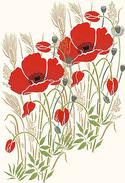On impulse, she bought a bouquet of poppies – all that New York City's Wanamaker's Department Store had – and handed them out to businessmen meeting at the New York YMCA where she worked. She asked them to wear the poppy as a tribute to the fallen. That was November 1918. World War I was over, but America's sons would rest forever “in Flanders Fields.” Later, she would spearhead a campaign that would result in the adoption of the poppy as the national symbol of sacrifice.
Poppy Day has become a familiar tradition in almost every American community. This distribution of the bright red memorial flower to the public is one of the oldest and most widely recognized programs of the American Legion Auxiliary.
Since the end of World War I, The American Legion Auxiliary Poppy has continued to bloom for the casualties of four more wars, its petals of paper bound together — for veterans by veterans — reminding America each year that the men and women who have served and died for their country deserve to be remembered.
Poppy Program
National Poppy Plan of Action (Login Required)
The Poppy Story
From the battlefields of World War I, weary soldiers brought home the memory of a barren landscape transformed by wild poppies, red as the blood that had soaked the soil. By that miracle of nature, the spirit of their lost comrades lived on.
The Red Poppy became a symbol of the sacrifice of lives in war, and represented the hope that none had died in vain.
This poppy, as a memorial flower to the war dead, can be traced to a single individual, Miss Moina Michael. She was so moved by Canadian Col. John McCrae's poem, “In Flanders Fields,” that she wrote a response:
. . . the blood of heroes never dies
But lends a luster to the red
Of the flower that blooms above the dead
In Flanders Fields.
Welcome to
American Legion Auxiliary
Department of Arkansas
P.O. Box 1010, Little Rock, AR, 72203
1415 West 7th Street, Little Rock, AR 72201
Phone: (501) 374-5836 | Fax: (501) 372-0855
email: arkaux@att.net



